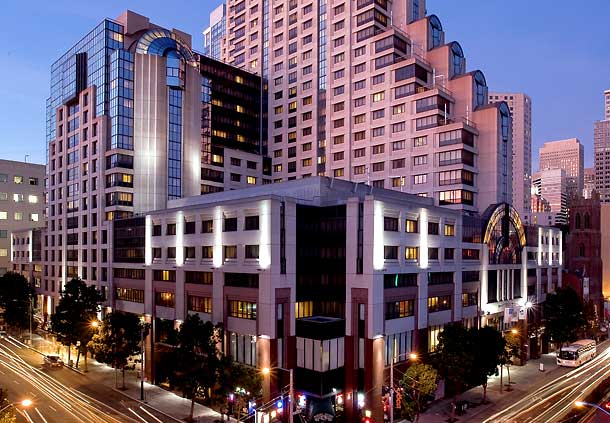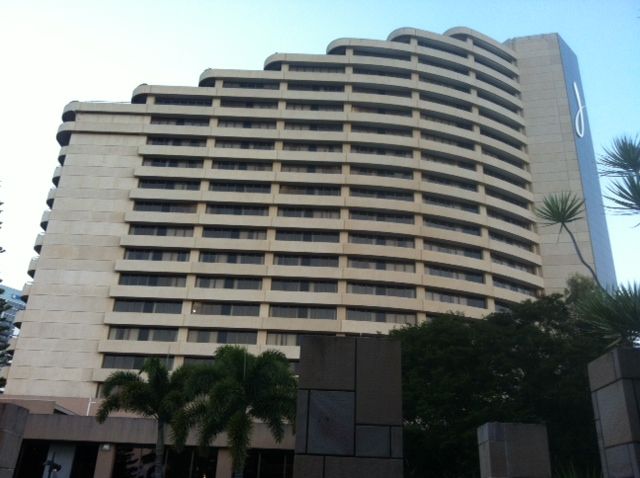Jupiter’s was built in the late 1980s as part of Australia’s initial casino mania. Today it’s looking its age despite several refurbishments in recent years.
Apart from the gambling room, the complex’s main attraction is its proximity to the Gold Coast Convention and Exhibition Centre.
Location
Jupiter’s Hotel and Casino is located centrally on the Gold Coast in Broadbeach, around 4km South of Surfers Paradise and 20km North of the Airport, right next to the Pacific Fair shopping mall.
The Casino sits on its own island some 500m away from the beach. The Gold Coast Convention Centre is a 200m walk from the hotel across an open air walkbridge.
Most of the time that walk will be fine but be prepared to get soaked in wet weather.
There is also a cheesy and largely pointless monorail that runs to the shopping complex across the highway. The $3 fare is reportedly waived for hotel guests but check at reception first.
Check-in
The front desk staff are friendly and helpful. There was no problem with checking in two hours before the official check-in time.
Asking reception for some fresh milk for the tea making facilities was no problem.
Rooms
While it’s claimed there have been ongoing refurbishments since 2008, the rooms are dated and tired, despite a relatively recent paint job.
Beds are comfortable and the blackout blinds do a good job of plunging the room into darkness and keeping the early morning or late evening sun out of the room on a hot day.
The bathroom, mini-bar and tea making facilities are basic but adequate. Each room has a digital combination safe as well as ironing equipment.
One aspect of the 1980s legacy is the scarcity of power points with only one double power outlet next to the fixed desk unit. Luckily there are nearby shopping centres to buy a powerboard if you can’t borrow one from reception.
Rooms have wireless and wired Internet available for a fee, although it may waived for convention guests. Surfing and downloads are extremely quick.
Amenities in the room are satisfactory with the standard range of free to air and cable TV stations including CNN, Bloomberg Asia and Sky.
Unfortunately the room doesn’t have dressing gowns and it’s little touches like that which let the hotel down.
Fitness Facilites
the Gym is well equipped with the usual range of weights, rowing and walking machines and open from 5.30am on weekdays.
It’s open to the public and could get crowded at busy times. The weekend times are fairly limited with Sunday being a stingy 8am to 4pm, Saturday’s are 7 to 5.
If you want a swim, there’s a large, warm pool next door to the gym and lap swimmers can get a 25m stretch if it isn’t busy. The pool area is open from 6am to 9pm and also has two spa baths.
Overall impressions
Jupiter’s desperately needs an investor to spruce the place up. The public areas are looking run down with chipped tiles and scuffed walls. Generally there’s a faded 1980s vibe about the place.
That 1980s feel also comes from the patrons, a midweek stay at Jupiter’s will find you sharing with a lot of grumpy seniors who are presumably playing the pokies (slot) and games in the casino.
In many respects Jupiter’s reflects much of what is wrong with Australian hospitality — a 1980s property that hasn’t had the investment to compete in the 21st Century catering for a declining, low value segment of the marketplace.
Overall the hotel is adequate but there are better deals to be had on the Gold Coast.
If you’re attending a conference at the Gold Coast Conference Centre then it may be worth checking out rooms at the nearby Sofitel or the many serviced apartments in the Broadbeach area.
Paul stayed at Jupiter’s Hotel and Casino courtesy of Microsoft when attending the 2012 Australian TechEd conference.
Similar posts:


